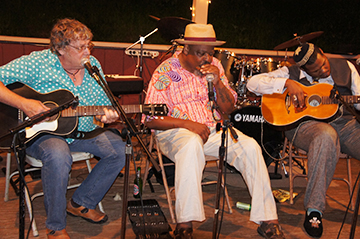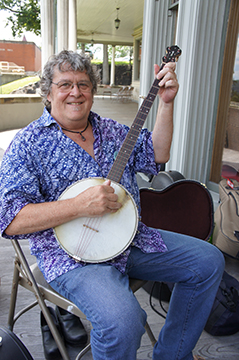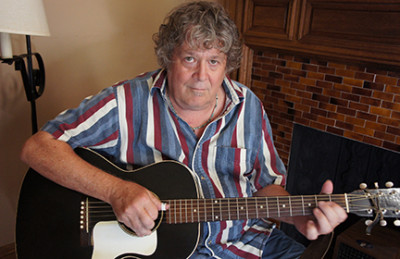Nobody likes direct comparisons to other musicians because inevitably it implies that they are somehow copying the style of another. There are some instances when comparisons are fitting, even necessary, especially good comparisons. This is such a case.

Down in Fountain, North Carolina, there is a first rate player who truly deserves comparison to a fellow North Carolinian, Doc Watson, not because he emulates or copies Watson, but because he has distinct similarities to Watson, who was one of the finest, most versatile American roots players of all time.
The songster Mike “Lightnin’” Wells didn’t pick that name to prop himself up as a bluesman, but it was actually his childhood nickname because he was the opposite of “fast as lightning.” When it comes to knowing a vast song repertoire of Appalachian roots blues and country, it’s this North Carolina bard. Wells is a superlative singer and instrumentalist on guitar, banjo and ukulele and a harmonica player. He can play anything, Delta, Piedmont, Mountain, Folk, Bluegrass and Hillbilly, 1920s and ‘30s crooners and everything in between – and how. His vast, seemingly encyclopedic repertoire of songs, stretches the full gamut of American roots music. Like Watson he is equally good as a singer and instrumentalist, a songster, an entertainer and a man whose love of playing shines through in every song he sings. And yes, he is every bit as good as Watson, but he is distinctly individual, a masterful player in his own right, a player of wonderful virtuosity and musical joy. He is not only a superb fingerpicker and slide player, his versatility and aesthetic is remarkable.
thecountryblues.com caught up with Wells to tell his story, “I moved to Carolina when I was 10 years old. I was born in Wheeling, West Virginia. Most of my family was from up there. I moved to Eastern Carolina when I was 10 years old. That would have been in 1962, to Goldsboro, North Carolina, which is in Eastern North Carolina, about an hour east of Raleigh.

My first instrument was the harmonica, that was in the third grade. I got interested in harmonica and my grandfather bought me a nice harmonica, it was a Hohner Old Standby. I was just a kid, but I learned some songs on it and was able to play the little songs in the book and it was like my first instrument. I never had a lesson or anything, I never knew what I was doing. But by the time I was in high school, I learned the cross harp – somehow figured it out by myself. I was also teaching myself guitar. When I was about 15 I started playing harmonica with the rack right away because I could already play the harmonica.
In high school I was playing pretty much what I play now, folk music and old-time music and the blues. I think when I first started playing guitar I learned flatpicking first. Woody Guthrie was a big influence. Then I went back listened to the Carter Family, Jimmie Rodgers, Lead Belly and Sonny Terry helped me get into blues. So then I actually was learning to fingerpick – I learned the first song when I taught myself to fingerpick – over and over and over and over was Spike Driver Blues, because it only had one chord. You didn’t have to change the chord. I think I originally heard that by Dave Van Ronk, I believe. That was an influential album, Dave Van Ronk Sings the Blues. He did a version of it on there and ended up getting to hear the Mississippi John Hurt version. I was finding all those reissues by the time I was in high school, like the Vanguard, and the “rediscovered” guys, like Son House on Columbia, Mississippi John Hurt Today, Skip James Today. Then Biograph was starting to do 78 rpm record reissues, the Paramount stuff they got from the John Steiner collection got me to hear Blind Blake, Blind Lemon Jefferson.
The Harry Smith Collection was a big, big influence.”
Wells plays music that is equally steeped in Appalachian and Piedmont musical traditions of both the black and white communities, as in this region there has always been cultural cross-pollination. He explained, “I worked with, all the Piedmont guys – like I hung out with John Dee Holman, and he loves Bill Monroe – “In the pines, in the pines” – he loves that stuff. Algia Mae Hinton – she named her daughter Minnie Pearl. She liked the Grand Ole Opry. George Higgs, he was influenced by the Grand Ole Opry – used to listen to that. He liked to listen to the harp player in the Opry, DeFord Bailey.”

“When I went to college to study English literature, I played blues already, and then I went to the University of North Carolina in the early ‘70s and I got to take some graduate folklore classes. The musicologist Bruce Bastin was going to school at the same time I was – except he was 30 years old, and he knew a whole lot about everything, and he’s bringing all these people to Chapel Hill when I was young. He was getting a doctorate. I was kind of intimidated because he knew everything and he as older than me and he would bring all these people. I could go down to my local bar in Chapel Hill and hear Guitar Shorty or Peg Leg Sam or somebody. It was amazing.
I started playing out in public then –I was kind of well-known to be young. I’d play in the bars there in Chapel Hill. I was collecting 78 rpm records.
My main mentor was Big Boy Henry – not musically but everything else. He was the first real blues guy. He taught me just how to look at life and stuff like that. I didn’t try to copy his licks or anything, because he was kind of limited as a guitar player. He played in E and A and he had the licks that he did that only he could do. But he does something that nobody does anymore – I never could do it, but he could come up with a fully formed song while he’s playing. Make it up on the spot and they were good ones, too. I remember we played a gig at Lincoln Center in New York – “Hey, what are we going to do next?” He said, “Play a song in D or A, it doesn’t matter.” It’s like hanging by the seat of your pants playing with him. A lot of people would try to play with him but he would change chords when he felt like it, like all those guys did. Once I could play with Big Boy. I wasn’t afraid to play with anybody after that.
Etta Baker was hard to play with. She had her own timing too. Taj Mahal – he played with me on my third CD. He played stand-up bass and just jamming with him.
In reflecting on my career, I mostly enjoyed the particular people I’ve met, especially like in Port Townsend and Augusta Blues weeks. It’s kind of like a family of the acoustic people. I’ve got to work with the best peole in the past, like Big Boy Henry, like Alga Mae Hinton. I still talk to her about every week. It’s like family.”
Lightning Wells tours nationally and internationally, and hearing him is a true listening pleasure. Even in these times when acoustic blues and traditional music is struggling, he is able to make a living, to sustain, in large part because he is truly one of the unsung masters, one of the finest in the land. He explained, “Well, times are always hard. You never have enough bookings. I look back, I’ve been doing this awhile. I have to pay my bills. I’ve been doing it, so I’m proud of that. I don’t know many people around here who are able to do that. It reminds me some, like I can hardly play around my hometown. The people always told me that – “Can’t ever play your hometown.” And you can, because people are so used to seeing you around. It’s a small town –“That’s nobody special – that’s just Lightnin’.”
Lightning Wells plays a black Gibson 1934– OO and a National Style O from the early 1930s. “ I have really nice instruments here at home. I have four banjos, and they’re all vintage, too. I have about 10 ukuleles, like a banjo uke, a tiple. Have you ever heard of a tiple? It’s like a 10-string instrument, metal strings, played like a ukulele. I’ve got a bunch of stuff like that. If I do gigs close to home I can carry more stuff, like I can carry two different ukuleles, two banjos. In fact, I have one I play nylon string banjo, a steel-string banjo. I’d like to record closer to home so I could have access to more of those instruments.”
For a versatile show of American roots music, you can find different players than Lighting Wells, but none better.

